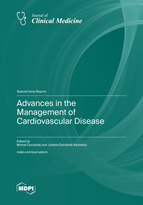Advances in the Management of Cardiovascular Disease
A special issue of Journal of Clinical Medicine (ISSN 2077-0383). This special issue belongs to the section "Cardiovascular Medicine".
Deadline for manuscript submissions: closed (30 September 2022) | Viewed by 45400
Special Issue Editors
Interests: pulmonary embolism; pulmonary hypertension; echocardiography; heart failure; anticoagulation
Special Issue Information
Dear Colleagues,
Cardiovascular diseases are still one of the leading causes of death worldwide. There is still rapid progress in the understanding of pathophysiology, diagnosis, and treatment of cardiovascular diseases. The ongoing progress of medicine makes it possible to improve the prognosis of patients. High-quality scientific studies are needed in order to explore current and new approaches to the pharmacological and non-pharmacological management of cardiovascular disease. The Journal of Clinical Medicine is planning a Special Issue titled “Advances in the Management of Cardiovascular Disease”. It is our great privilege to invite you to contribute to this Special Issue. We are interested in clinical and epidemiological studies and systematic reviews with a focus on the management of cardiovascular disease.
Prof. Michał Ciurzyński
Dr. Justyna Domienik-Karłowicz
Guest Editors
Manuscript Submission Information
Manuscripts should be submitted online at www.mdpi.com by registering and logging in to this website. Once you are registered, click here to go to the submission form. Manuscripts can be submitted until the deadline. All submissions that pass pre-check are peer-reviewed. Accepted papers will be published continuously in the journal (as soon as accepted) and will be listed together on the special issue website. Research articles, review articles as well as short communications are invited. For planned papers, a title and short abstract (about 100 words) can be sent to the Editorial Office for announcement on this website.
Submitted manuscripts should not have been published previously, nor be under consideration for publication elsewhere (except conference proceedings papers). All manuscripts are thoroughly refereed through a single-blind peer-review process. A guide for authors and other relevant information for submission of manuscripts is available on the Instructions for Authors page. Journal of Clinical Medicine is an international peer-reviewed open access semimonthly journal published by MDPI.
Please visit the Instructions for Authors page before submitting a manuscript. The Article Processing Charge (APC) for publication in this open access journal is 2600 CHF (Swiss Francs). Submitted papers should be well formatted and use good English. Authors may use MDPI's English editing service prior to publication or during author revisions.
Keywords
- Venous thromboembolism
- Pulmonary embolism
- Biomarkers
- Heart failure
- Echocardiography
- Connective tissue disease
- Arrhythmias
- Obesity
- Acute coronary syndromes
- Lipids







